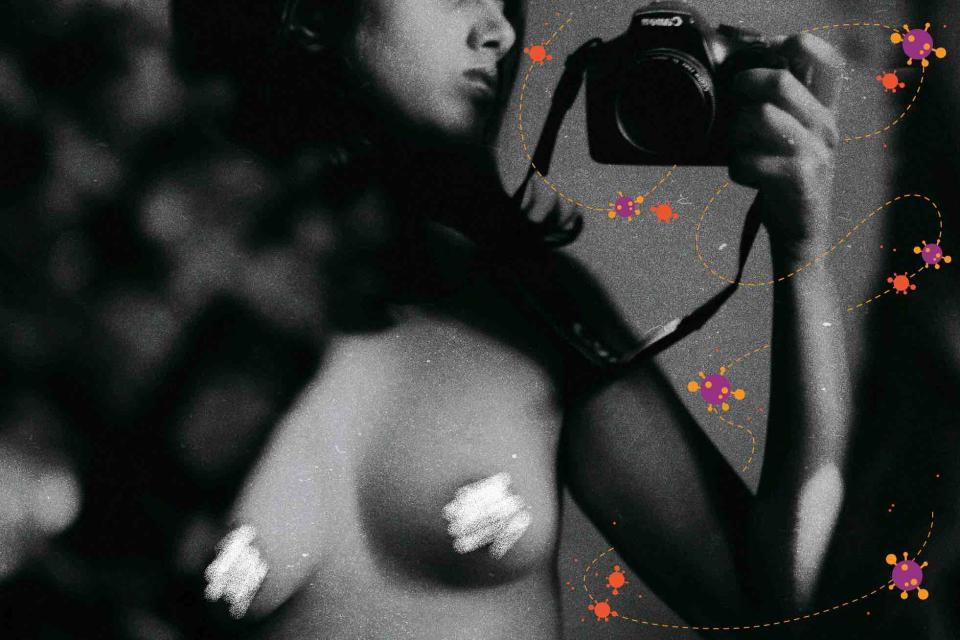
Image: Photograph and art by GayXSwan, composite image by Paru Ramesh.
One has always scoffed, sniggered or screamed on hearing the phrase: “It was the best of times, it was the worst of times.” This infamous opening from Charles Dickens’ A Tale of Two Cities has been bandied about on almost every occasion from the fun to the funereal. Though, you’ll have to forgive me while I go ahead and use it as a crutch myself to describe these present times of COVID-19. With the declaration that this is a global pandemic, there has been acceleration in the ways that we’re seeing established government systems breaking down, we’re seeing the rupture of polite pretences and the exposition of prejudices in society, and the reconfiguring of the concept of “essentials” and “essential services” and so many other little things that need to be reset that we’ve regarded as “normal” all this while.
In the Indian context, right-wing, nationalistic politics since the election of the present Prime Minister Narendra Modi in 2014 has found a new lease of life. In a lot of ways, one could argue that it piggybacked on the penetration of technology to mount its campaign stirring hate and violence primarily among the Hindu and Muslim communities as well as arresting activists and protestors who dared to dissent. It has turned out that this agenda of “Hindu Nation” has rather gained momentum in this time of COVID-19 instead of taking a backseat. This unstoppable charge in turn has forced all minority communities in the country – across all domains of society – to relook at the way they engage with their present, their publics, their politics and their practices as well.
It has turned out that this agenda of “Hindu Nation” has rather gained momentum in this time of COVID-19 instead of taking a backseat.
On 24 March at 8 pm, this country of 1.3 billion was given less than four hours before a country-wide lockdown was called by the Prime Minister without any kind of socio-economic stimulus package or plan. While it has brought the nation’s economy to a grinding halt, it has hit informal sectors in a way that is still being collated and calculated.
In this article, the attempt is to look at the way that women and queer practitioners across India have adapted to the present state of affairs and the plans they’re hatching for the time after this.
Can You Hear? The Signal Keeps Dropping.
It has always been hard to be an artist-practitioner in this country. And in these times, it has become even harder. While being resilient and subverting popular modes of engagement has been the hope, in truth, it has still largely continued to function through established systems of the universal art world. In this lockdown though, it seems those practitioners who have been nudging out space to showcase or present alternative practices are using social media platforms to hijack the conversation of production and product.
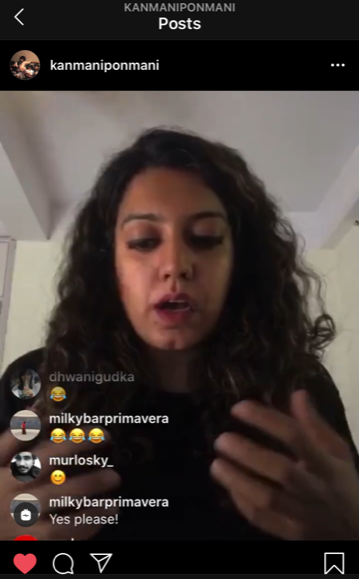
Image description: Screenshot of Instagram live chat. Artist: Meenakshi Thirukode.
For Delhi-based independent practitioner and curator Meenakshi Thirukode of Instituting Otherwise, this sudden and striking withdrawal of bodies from public spaces during these efforts at flattening the curve didn’t affect her practice but rather invigorated it. “To be honest, I didn’t feel any different, I’ve not had a regular 9-to-5 job. So, whatever I’m producing now, is in a way a response to the circumstances we live in – social, political and cultural...that’s at the core of my practice, which is a sort of ‘survival’ tactic, you know? Of course, I was looking for work to help me sustain financially but that has now taken a backseat, so I will feel that pinch for sure,” she writes. Meenakshi has taken to her Instagram account “to create a space for thinking, engaging, introspecting” that has culminated into ten weekly Curatorial Masterclasses that build on her foundational ethos of “often small scale [projects] and creating different kinds of intimate community spaces to generate different discourses”. So far, she’s tackled themes from conceptions of productivity to friendships as sites for curatorial radicality to unlearning the art market in her Instagram live sessions. She’s also invited practitioners on the outside of systems from across the world to discuss the concerns and futures of artistic practice and practitioners.
While brick-and-mortar galleries have been attempting online showcases for a while now, Meenakshi sees this response in the lockdown as “just a knee-jerk reaction”. She argues that “it is not rooted in a sustained, thoughtful practice per se. So it’s probably not going to last that long and produce anything interesting. But what will be interesting – is for those functioning in those small scales, and in spaces of precarity for the longest time and living and surviving through a good hustle who would have developed the tools to create something meaningful.”
There’s Enough Bandwidth, Right?
On the second day of the lockdown itself [in Karnataka on March 21], Rohini Kejriwal – a poet, writer and illustrator based in Bangalore – who is more popularly known as the founder of The Alipore Post a newsletter and online journal that highlights poetry, art and other unique finds of the internet came up with The Alipore Post Online, a 12-hour Instagram Live festival with 30 speakers, performances and artists. “I discovered Instagram Live as the medium of engagement through a drawing class with Wendy MacNaughton,” she writes in an email interview.
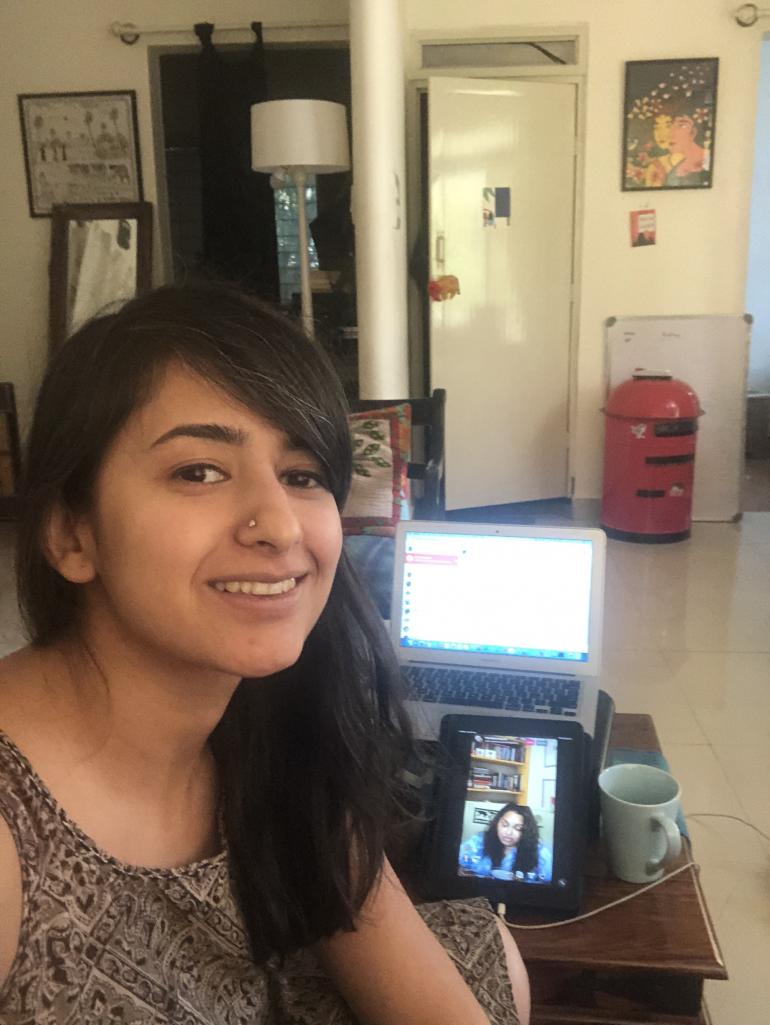
Image description: Rohini Kejriwal in front of multiple devices, one showing a video call. Reproduced with permission from artist.
Rohini had very early on realised the tandem role that the online and offline spaces would play in building community around artistic practice. “I started doing The Alipore Post Offline from the second year of the newsletter in September 2016. I was really big on festivals and the music scene then, and decided to do these massive weekend-long events for the community to gather, not focus on being high but learning through workshops, watching performances, and just having a physical manifestation of the online space. And apart from these, I’ve organised a bunch of poetry writing and appreciation workshops + zine-making sessions at home and outside, in the same attempt of democratising the creative process and enabling people with the freedom to be artists and poets, to find the means of expression and coping. So doing this festival online in one week was crazy because it went from an idea to reality in no time, with all the people I’d have killed to have on a festival lineup, with no venue cost and was free for everyone,” she tells us.
Rohini had very early on realised the tandem role that the online and offline spaces would play in building community around artistic practice.
In her navigation and negotiation between the virtual and the real, Rohini has come to hedge her bet on a few certainties. “I think virtual is going to be the way forward for a few months, definitely. There are virtual offices, tutorials, meetings, and every other kind of human interaction taking place on screens. The internet IS real. And people need to claim the space and use it to its fullest,” she attests. “We’ll navigate the distances and contexts as they arise. We may need to change the vocabulary and nomenclature of stuff. I’m curious to see what the future of work will be,” she adds.
The Video Isn’t Working? There Is No Image On The Screen.
Using social media as a platform for presentation and promotion of their work isn’t new among contemporary practitioners, and while it has come with freedom, ease, direct access to one’s community and so on. They’ve also had to encounter censorship of content (like no female nipples), or their works not showing up on feeds because it is sorted by an algorithmic pattern that we know nothing about (but apparently prefers faces). For Delhi-based lawyer and photographer Elina Bannerjee, Instagram did seem perfect, its “foundation was giving artists a space to flourish” but her subject matter – photography of her own body hasn’t been given the same chances. Her Instagram handle GayXSwan, a personal project she has been running for five years now, was deleted this year, while before this the algorithm had made it difficult to find citing community guidelines. “Censorship [on Instagram] is a discriminatory tool against not just specific genders but also nudity,” she says in an email interview.
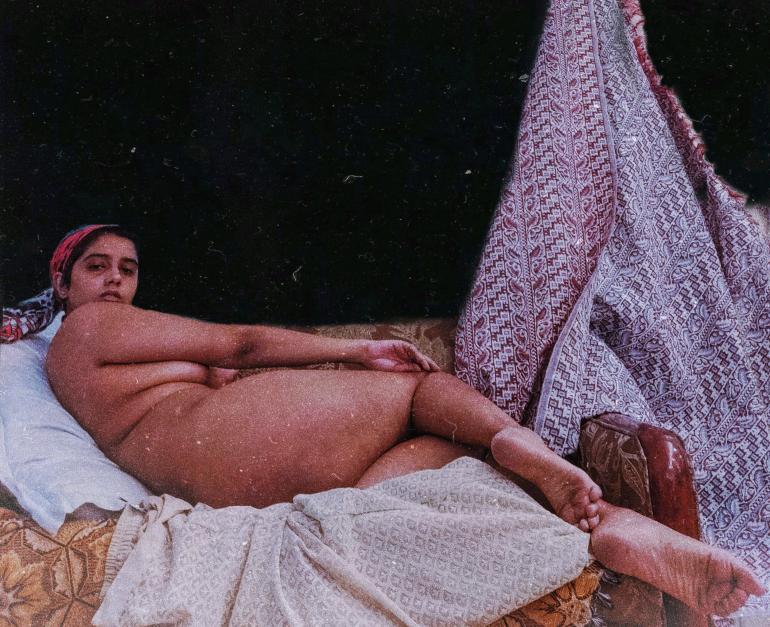
Image description: A woman lying down looking over shoulder. Source: artist
On seeing Elina’s images, one might notice specific interventions made post-production on these images, while they might read as a response to reporting by the community and censorship of Instagram, it isn’t so but rather subverts this idea too. “As an artist, I don’t support any act of censorship especially of those concepts explored through the skin and by bodies. The alteration of the images is a choice, an experiment. It does create a censored feel to the raw images but the effect of the image still translates when viewed in its totality. The ‘grain effect’ on work is an attempt at showing that even images that have been pixelated reflect the bare truth,” she argues. “Censorship on these platforms demands specific areas be removed that ‘doesn’t suit’ the eye but manipulating or playing with my work is a choice,” she adds. This ability to skip around censorship and restriction and still present as themselves has been a hallmark of the ways different genders and bodies navigate online and offline spaces in the past.
This ability to skip around censorship and restriction and still present as themselves has been a hallmark of the ways different genders and bodies navigate online and offline spaces in the past.
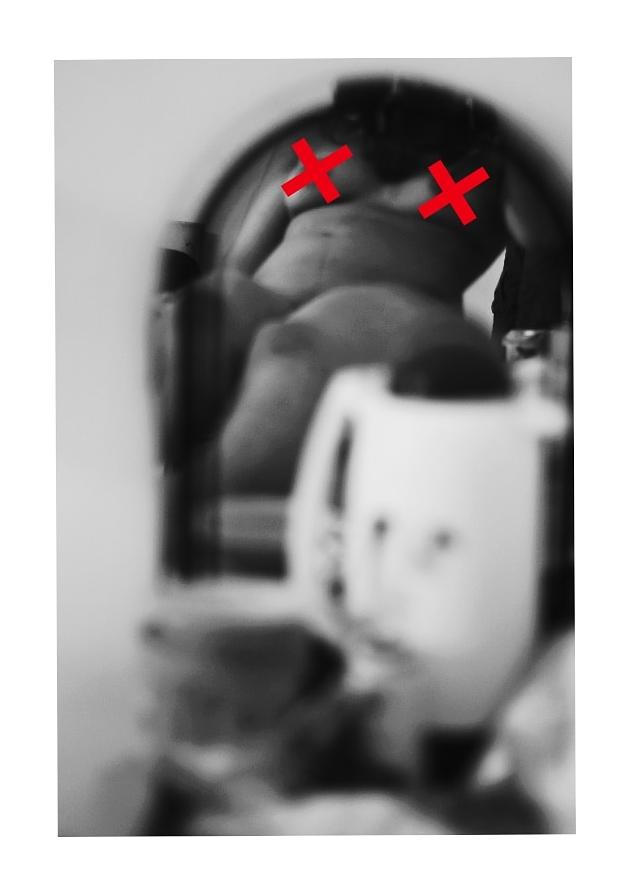
Image description: View of naked body, X on nipples. Image source: artist
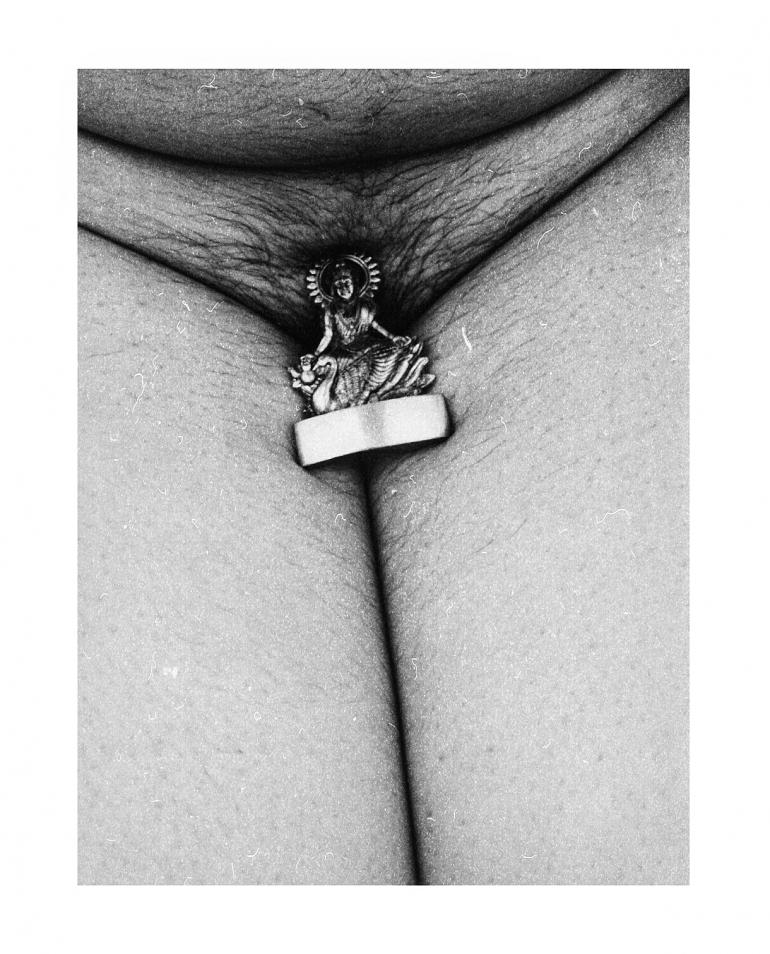
Image description: Small statue placed on public hair and legs. Image source: artist
Can You Say That Again, Please? It Wasn’t Clear.
It is these kinds of deliberate moves that have always opened up spaces for marginalised communities and bodies. “I feel the web can be an open space if used strategically. I have had a wide range of responses to the web-based project I have started during the lockdown,” says Pallavi Paul, a Delhi-based artist and PhD in cinema studies’ student. As part of Sunaparanta Goa Centre for the Arts’ ongoing series – Surviving SQ – she has been asking people to send ten-second audio clips of the silence in their confined spaces for her project – Share Your Quiet. “People have felt little pressure to be productive while also feeling more sensorily alert. The web has been a good space to express this. This could perhaps be read as a corollary of freedom,” she hazards.
For Pallavi, the “limits to market-oriented productivity are too obvious” and she sees this lockdown has an opportunity to rethink practice and productivity as artists too. “This is a long haul and I feel that we need more people to produce the grounds where an alternative to this dark spiral can be re-imagined. Artists have helped with that during other traumatic times in history, and here too one hopes that hope will be made possible by art too,” she writes. Pallavi also wonders if another kind of straddling between two worlds will be required to continue to be artists and practitioners. “I feel what many of us have been doing anyway, i.e. doing jobs to fund our artistic works will have to become a larger model for the arts to survive at all. In fact, I feel if artists have non-art jobs then a healthier relationship between art and the other worlds can be made possible. Time [among others things] will have to be reinvented when this is over,” she suspects.
Artists have helped with that during other traumatic times in history, and here too one hopes that hope will be made possible by art too.
Is The Line Breaking Up?
In the case of artists in the developing world, it is access to international grants and residences that allow artists over here to be full-time artists. And those resources look like they might be severely affected in the world after this lockdown. While women and queer artists in other countries have received some financial aid from the State to help them tide over this uncertain time, in India where there was already very little support, there’s likely to be even less now or even nothing. “In this environment, because we are staring at a global recession, all international networks may also be dry for a while. I hope when the physical danger of COVID-19 subsides more focused grants are announced for art workers who will keep the discourse of art ticking by continuing to produce art. I hope we turn an interesting corner into thinking of artistic ideas and art objects not as causally linked, rather as cross-transmissions. I hope more collaborations, resource sharing and collective practices emerge in the future,” Paul writes hopefully.
Independent curator Meenakshi packs a provocative punch while also acknowledging the effect of this time on practitioners. “We’ve always known fear regardless, haven't we? As women and queer folx? I am actually thinking of the virus as a kin – I think its brought about an isolation and loneliness to those who never understood these feelings in the way that women and queer folk have known and felt, sometimes all their life,” she says. She continues to point out that large infrastructures will never respond the right way and might end up looking like absolute fools in the process. “But funnily: and I of course say this fully knowing there is suffering and loss (but when has there never been that kind of suffering and loss for the poor, the disenfranchised?) but I fear that we will create our communities a lot less than before. Because this one really poked the bear where it hurt – I relate to such anarchy,” she says signing off with a smiley face.
We’ve always known fear regardless, haven't we? As women and queer folx?
- 4763 views

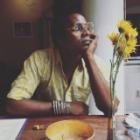





Add new comment